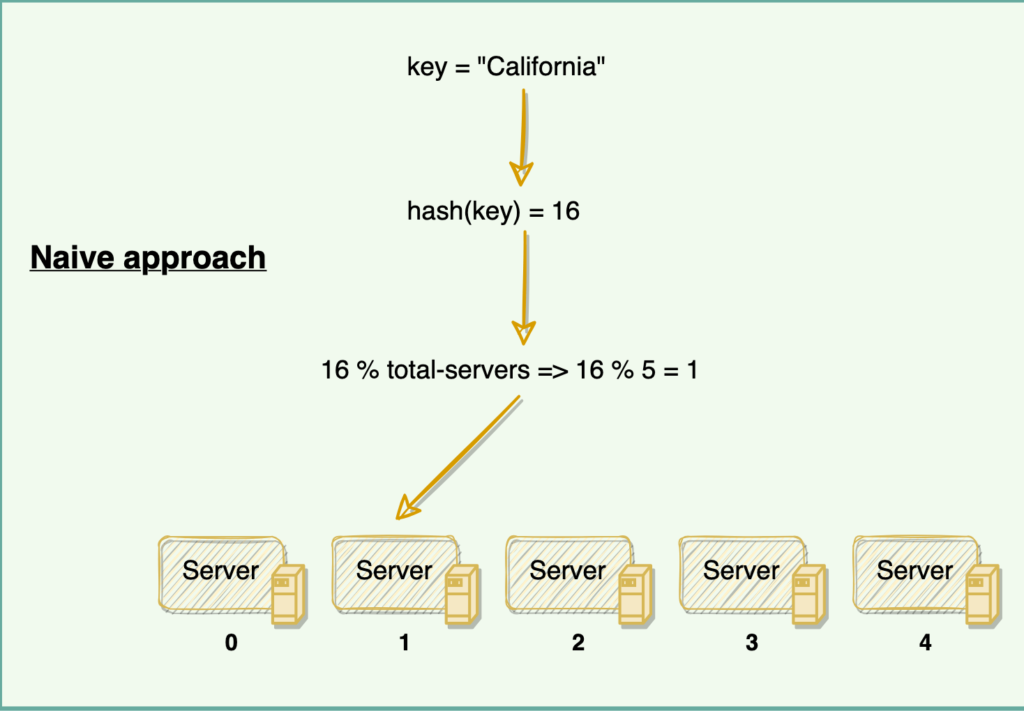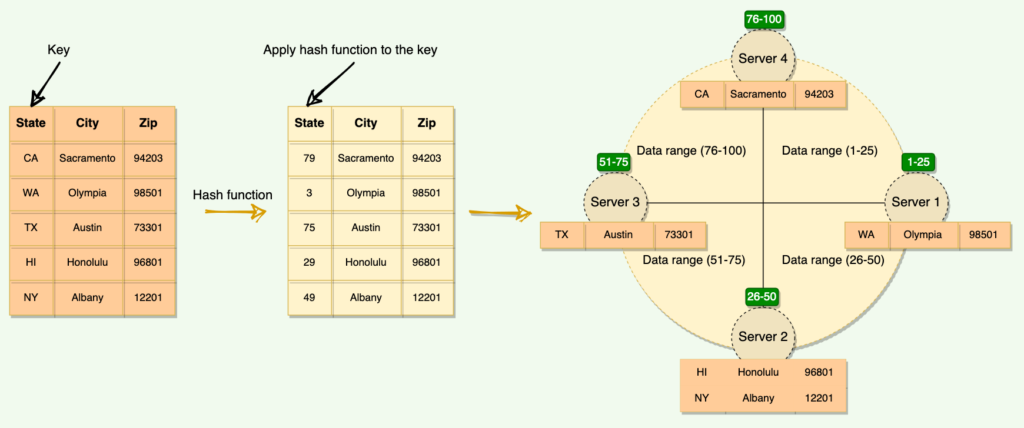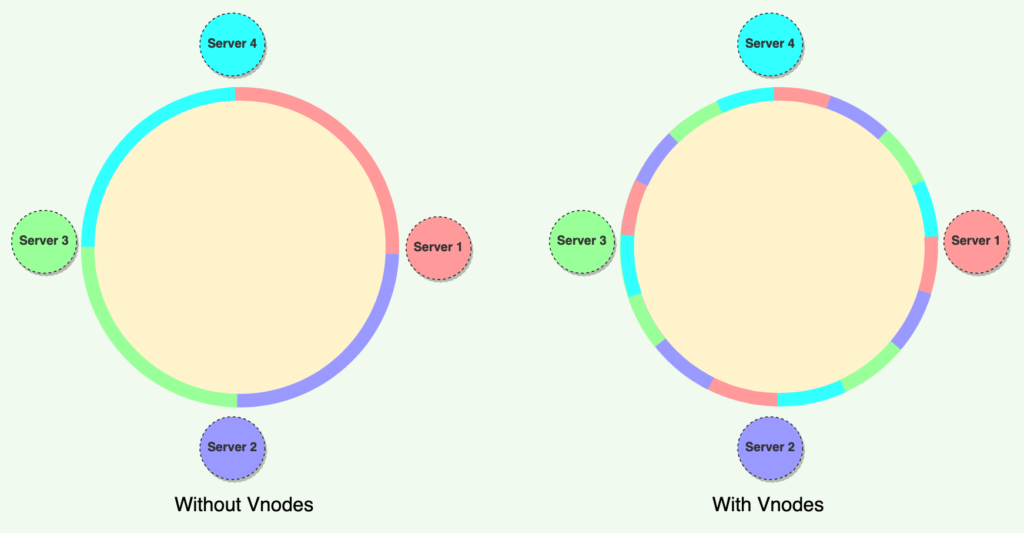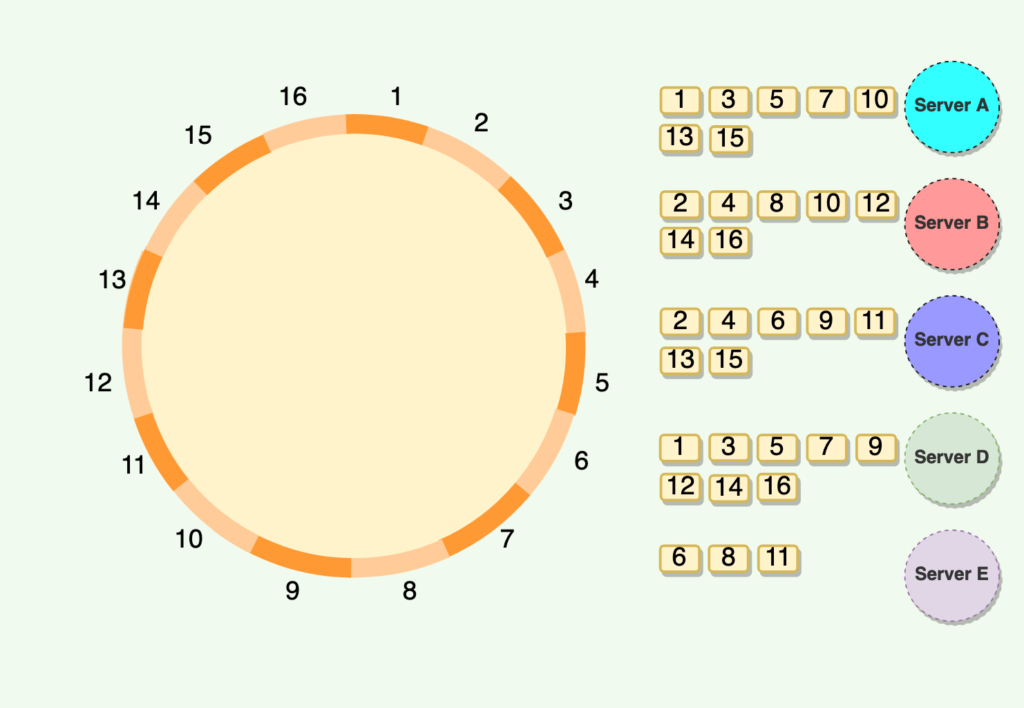Data Partitioning
In this tutorial, we are going to discuss about Data Partitioning. Data partitioning is a method used to distribute data across multiple physical storage units to improve scalability, performance, and manageability. In the context of databases, partitioning involves dividing a large dataset into smaller, more manageable pieces, or partitions, that can be stored, accessed, and managed independently.
What is data partitioning?
The act of distributing data across a set of nodes is called data partitioning. There are two challenges when we try to distribute data:
- How do we know on which node a particular piece of data will be stored?
- When we add or remove nodes, how do we know what data will be moved from existing nodes to the new nodes? Furthermore, how can we minimize data movement when nodes join or leave?
A naive approach will be to use a suitable hash function that maps the data key to a number. Then, find the server by applying modulo on this number and the total number of servers. For example:

The scheme described in the above diagram solves the problem of finding a server for storing/retrieving the data. But when we add or remove a server, we have to remap all the keys and move the data based on the new server count, which will be a complete mess!
Dynamo uses consistent hashing to solve these problems. The consistent hashing algorithm helps Dynamo map rows to physical nodes and also ensures that only a small set of keys move when servers are added or removed.
Consistent hashing: Dynamo’s data distribution
Consistent hashing represents the data managed by a cluster as a ring. Each node in the ring is assigned a range of data. Dynamo uses the consistent hashing algorithm to determine what row is stored to what node. Here is an example of the consistent hashing ring:

With consistent hashing, the ring is divided into smaller predefined ranges. Each node is assigned one of these ranges. In Dynamo’s terminology, the start of the range is called a token. This means that each node will be assigned one token. The range assigned to each node is computed as follows:
Range start: Token value
Range end: Next token value – 1
Here are the tokens and data ranges of the four nodes described in the above diagram:

Whenever Dynamo is serving a put() or a get() request, the first step it performs is to apply the MD5 hashing algorithm to the key. The output of this hashing algorithm determines within which range the data lies and hence, on which node the data will be stored. As we saw above, each node in Dynamo is supposed to store data for a fixed range. Hence, the hash generated from the data key tells us the node where the data will be stored. Here is an example showing how data gets distributed across the Consistent Hashing ring:

The consistent hashing scheme described above works great when a node is added or removed from the ring; as only the next node is affected in these scenarios. For example, when a node is removed, the next node becomes responsible for all of the keys stored on the outgoing node. However, this scheme can result in non-uniform data and load distribution. Dynamo solves these issues with the help of Virtual nodes.
Virtual nodes
Adding and removing nodes in any distributed system is quite common. Existing nodes can die and may need to be decommissioned. Similarly, new nodes may be added to an existing cluster to meet growing demands. Dynamo efficiently handles these scenarios through the use of virtual nodes (or Vnodes).
As we saw above, the basic Consistent Hashing algorithm assigns a single token (or a consecutive hash range) to each physical node. This was a static division of ranges that requires calculating tokens based on a given number of nodes. This scheme made adding or replacing a node an expensive operation, as, in this case, we would like to rebalance and distribute the data to all other nodes, resulting in moving a lot of data. Here are a few potential issues associated with a manual and fixed division of the ranges:
- Adding or removing nodes: Adding or removing nodes will result in recomputing the tokens causing a significant administrative overhead for a large cluster.
- Hotspots: Since each node is assigned one large range, if the data is not evenly distributed, some nodes can become hotspots.
- Node rebuilding: Since each node’s data is replicated on a fixed number of nodes (discussed later), when we need to rebuild a node, only its replica nodes can provide the data. This puts a lot of pressure on the replica nodes and can lead to service degradation.
To handle these issues, Dynamo introduced a new scheme for distributing the tokens to physical nodes. Instead of assigning a single token to a node, the hash range is divided into multiple smaller ranges, and each physical node is assigned multiple of these smaller ranges. Each of these subranges is called a Vnode. With Vnodes, instead of a node being responsible for just one token, it is responsible for many tokens (or subranges).

Practically, Vnodes are randomly distributed across the cluster and are generally non-contiguous so that no two neighboring Vnodes are assigned to the same physical node. Furthermore, nodes do carry replicas of other nodes for fault-tolerance. Also, since there can be heterogeneous machines in the clusters, some servers might hold more Vnodes than others. The figure below shows how physical nodes A, B, C, D, & E are using Vnodes of the Consistent Hash ring. Each physical node is assigned a set of Vnodes and each Vnode is replicated once.

Advantages of Vnodes
Vnodes give the following advantages:
- Vnodes help spread the load more evenly across the physical nodes on the cluster by dividing the hash ranges into smaller subranges. This speeds up the rebalancing process after adding or removing nodes. When a new node is added, it receives many Vnodes from the existing nodes to maintain a balanced cluster. Similarly, when a node needs to be rebuilt, instead of getting data from a fixed number of replicas, many nodes participate in the rebuild process.
- Vnodes make it easier to maintain a cluster containing heterogeneous machines. This means, with Vnodes, we can assign a high number of ranges to a powerful server and a lower number of ranges to a less powerful server.
- Since Vnodes help assign smaller ranges to each physical node, the probability of hotspots is much less than the basic Consistent Hashing scheme which uses one big range per node.
That’s all about the Data Partitioning. If you have any queries or feedback, please write us email at contact@waytoeasylearn.com. Enjoy learning, Enjoy system design..!!